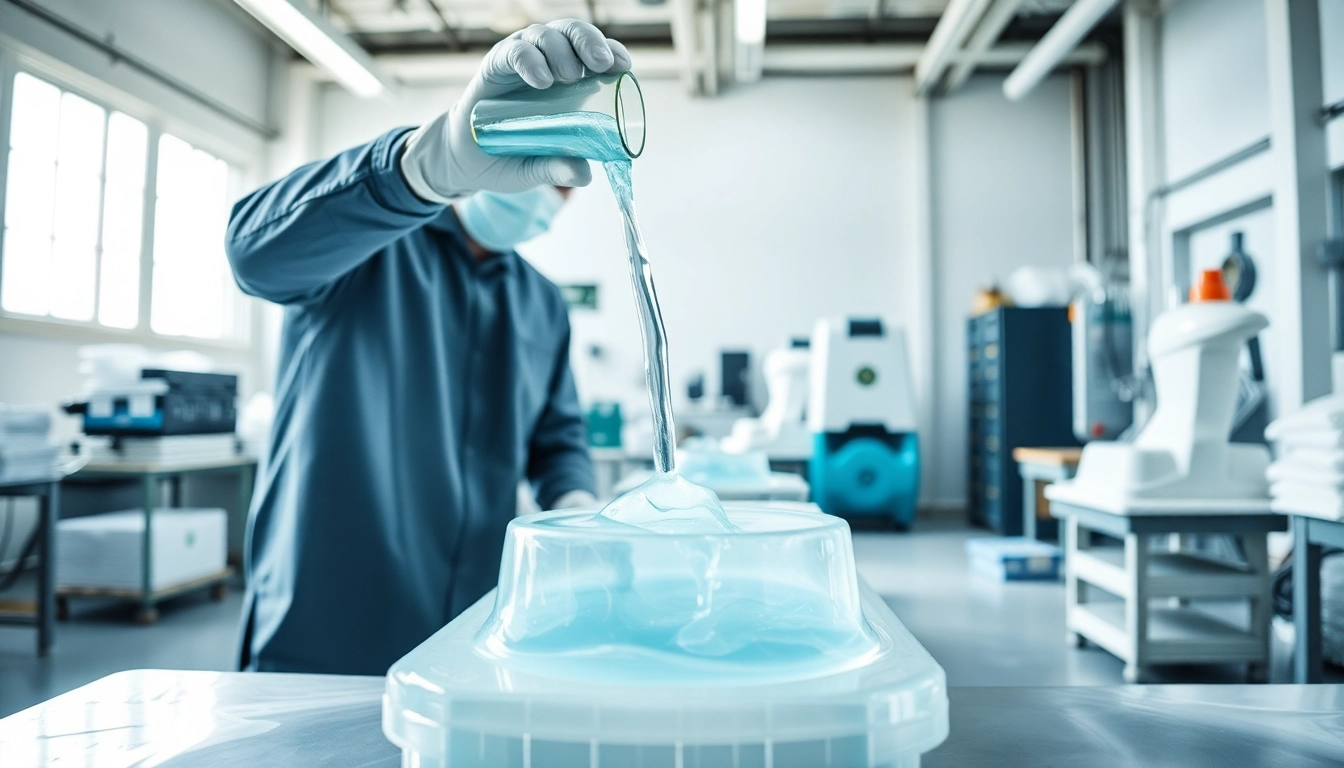Understanding Infusion Resins
Infusion resins are specialized compounds used in the composite manufacturing process, particularly for creating strong, lightweight structures. When combined with fibers, like carbon or glass, these resins form composite materials that are integral to various industries, such as aerospace, automotive, and marine. The infusion process is vital as it allows for the incorporation of resin into dry fiber preforms under vacuum conditions, enhancing the quality and performance of the final product. For an in-depth look at infusion resins, you can explore our comprehensive segment on infusion resins.
What Are Infusion Resins?
Infusion resins are typically low-viscosity resins utilized in a technique known as resin infusion or vacuum bagging. This process involves drawing out air from a dry fiber substrate using a vacuum pump, after which the resin is drawn into the void created in the fabric. This method ensures a complete permeation of the fibers with resin, leading to exceptional mechanical properties in the resulting composite. Unlike traditional hand lay-up techniques, infusion resins provide a more controlled, uniform distribution of resin, mitigating air bubbles and voids that can weaken the structure.
Key Benefits of Using Infusion Resins
The advantages of using infusion resins extend beyond mere strength; they include:
- High Strength-to-Weight Ratio: Infusion resins, when fully cured with appropriate fibers, provide outstanding strength while keeping the overall weight of the composite minimal.
- Enhanced Surface Finish: The infusion process results in a smooth surface finish, allowing for better aesthetics and reduced need for post-processing.
- Controlled Resin Flow: Low viscosity in infusion resins facilitates controlled flow into complex geometries, ensuring complete wet-out of fibers.
- Minimal Environmental Impact: Some infusion resins are formulated from bio-based materials, resulting in a lower environmental footprint compared to traditional resins.
- Reduced Labor Costs: The infusion process can be more automated, leading to reduced labor time and costs in manufacturing.
Common Applications in Industry
Infusion resins find applications across various sectors, including:
- Aerospace: Used in the manufacturing of lightweight components such as wing structures, fuselage sections, and tail components that demand high endurance and minimal weight.
- Automotive: Employed in fabricating parts including body panels, frames, and structural components for improved fuel efficiency and performance.
- Marine: Essential for making hulls and decks of boats, where strength and resistance to water damage are crucial.
- Wind Energy: Utilized in creating turbine blades that require lightweight yet strong materials capable of enduring harsh environmental conditions.
Types of Infusion Resins
Low-Viscosity Infusion Resins
Low-viscosity infusion resins are engineered specifically for the infusion process. They are designed to penetrate through the fiber layers easily, ensuring complete wet-out and reducing the likelihood of air entrapment. These resins are critical in applications that require intricate shapes and complex structures where uniformity is essential.
High-Performance Epoxy Resins
High-performance epoxy resins are favored for their superior mechanical properties and thermal stability. They are ideal for applications that require high strength and resistance to environmental factors such as moisture, UV exposure, and temperature fluctuations. Their adhesive properties make them suitable for bonding various substrates, enhancing the overall integrity of the composite structures.
Bio-Based Infusion Resins
Bio-based infusion resins represent a significant advancement in sustainable materials technology. Made from renewable resources, these resins not only reduce reliance on fossil fuels but also aim to minimalize environmental impact. They maintain performance characteristics comparable to traditional resins while contributing positively to the environmental landscape.
Resin Infusion Process Explained
Materials Needed for Infusion Resins
To successfully execute a resin infusion process, several materials are essential:
- Low-viscosity infusion resin
- Fiberglass or carbon fiber fabric
- Vacuum bagging materials (film, sealant, etc.)
- Vacuum pump and gauge
- Mold or tooling surfaces
- Release agents
Step-by-Step Guide to Resin Infusion
Executing a resin infusion successfully involves several key steps:
- Prepare the Mold: Ensure that the mold is clean, free from dust, and apply a suitable release agent to prevent sticking.
- Lay Up the Fibers: Arrange the fabric in the mold in the desired orientation, ensuring adequate coverage.
- Set Up the Vacuum Bag: Cover the assembly with vacuum bagging film and seal it to ensure no air can escape.
- Make Connections: Attach the resin inlet and vacuum lines to the bag to facilitate resin flow and air evacuation.
- Start the Vacuum Pump: Begin drawing a vacuum on the bag, monitoring for leaks and ensuring proper vacuum levels are achieved.
- Inject the Resin: Once a vacuum is established, introduce the resin into the system, allowing it to flow throughout the fibers.
- Cure the Composite: Allow the resin to cure fully as per the product specifications before demolding.
Safety Considerations When Working with Resins
Handling resins safely is crucial for both personal health and environmental protection. Follow these safety measures:
- Wear appropriate personal protective equipment (PPE), including gloves, goggles, and respirators to mitigate exposure to fumes and skin contact.
- Ensure adequate ventilation in the workspace to disperse any hazardous vapors.
- Store resin materials according to manufacturer specifications and in a controlled environment to prevent degradation.
- Dispose of any resin waste responsibly, adhering to local regulations to minimize environmental impact.
Choosing the Right Infusion Resins
Factors to Consider for Optimal Performance
Selecting the appropriate infusion resins for your project involves understanding various factors:
- Viscosity: Choose a resin with the right viscosity for your specific application to ensure proper flow and wet-out.
- Cure Time: Consider the working time available and how it affects the infusion process, especially in larger projects.
- Mechanical Properties: Evaluate the required mechanical characteristics, such as tensile strength and rigidity, for your end product.
- Environmental Resistance: Assess the environmental conditions the finished product will face and select a resin that can withstand those conditions.
Comparing Different Brands of Infusion Resins
When assessing various brands of infusion resins, consider aspects such as:
- Performance metrics based on application needs.
- Consistency of quality in different batch productions.
- Technical support offered, including guidance and resources for troubleshooting.
- Flexibility in formulations for customized needs and alternative applications.
Evaluating Resin Properties for Specific Projects
Each project may have unique demands; as such, assessing resin properties is paramount:
- Determine the desired temperature resistance based on the application.
- Assess mechanical stresses expected during use to ensure compatibility with the chosen resin.
- Check for special requirements, such as electrical insulation properties if applicable.
Future Trends in Infusion Resins
Innovations in Resin Chemistry
Research and development in resin chemistry continue to evolve, leading to innovative solutions that enhance performance. For example, advancements are being made in hybrid resins that combine properties of different materials, offering tailored solutions for specific applications.
Sustainable Practices in Resin Production
The push for eco-friendly materials has led to a rise in the development of sustainable practices within resin production. Manufacturers are exploring biocompatible materials that reduce environmental impact while maintaining performance integrity. This shift signifies a broader industry trend toward sustainability in composite materials.
Market Predictions for Infusion Resins
The infusion resins market is projected to grow significantly as the demand for lightweight, high-performance materials continues to rise. Trends indicate a shift towards automation in the infusion process, increasing efficiency and consistency while reducing costs. Additionally, with ongoing advancements in material science, we can expect further innovations in resin formulations, tailored to meet the evolving needs of diverse industries.



